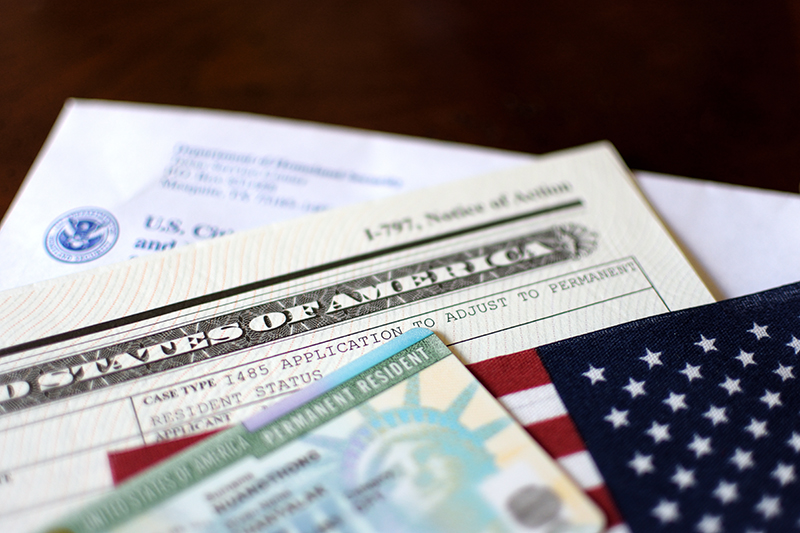Adjustment of Status is a process that allows individuals currently residing in the United States to apply for lawful permanent resident status, more commonly known as obtaining a Green Card. This procedure enables qualifying people to transition from being temporary non-immigrants to permanent residents without the need to return to their home country for visa processing. Significant for its implications on an individual’s legal status and future in the United States, this pathway to permanent residency is facilitated by the United States Citizenship and Immigration Services (USCIS).
Our journey through the adjustment of status involves meticulous evaluation of eligibility criteria, assembling the required documentation, and navigating the complexities of immigration law. We need to have a clear understanding of the forms to be filed, fees to be paid, and the various stages of the application process. The eligibility to adjust status varies greatly, often depending on our current immigration status, our relationship to a U.S. citizen or lawful permanent resident, and our ability to meet certain admissibility requirements.
As we embark on this transformative process, our aim is to gain lawful permanent resident status, which bestows upon us the right to live and work in the United States indefinitely. Not only does adjustment of status provide us a pathway to stability and security, but it also holds the potential for eventual citizenship. Our commitment to adherence to USCIS regulations and procedures is crucial for the successful navigation through this nuanced path toward making the United States our permanent home. learn more about Adjustment of Status
Eligibility and Application Process
The process of becoming a U.S. permanent resident through Adjustment of Status consists of determining your eligibility, completing necessary forms, compiling supporting documents, and managing submission and fee requirements.
Adjustment of status is the process by which an individual already present in the United States can apply for lawful permanent residency (a green card) without having to return to their home country. This procedure is typically available to those who meet specific eligibility criteria, such as family-based or employment-based petitions, asylum seekers, or individuals covered under special programs. Through adjustment of status, applicants undergo background checks, medical examinations, and an interview with U.S. Citizenship and Immigration Services (USCIS). Once approved, they can obtain permanent residency, allowing them to live and work in the U.S. legally. The process can be complex, often requiring careful preparation and legal guidance to ensure a successful outcome.
Determining Eligibility
First, we must establish whether we are eligible for Adjustment of Status. Eligibility largely depends on an approved immigrant petition, such as Form I-130, by a family member or employer. Refugees, asylees, and certain other categories like U.S. citizen spouses may also apply. We must confirm that an immigrant visa is available when applying, unless we are immediate relatives of U.S. citizens.
Filling Out Form I-485
Next, we fill out Form I-485, the Application to Register Permanent Residence or Adjust Status. This form requires comprehensive personal information, immigration history, and details about our entry into the U.S. Accuracy and completeness are crucial, as any mistakes can lead to delays or denials.
Supplementary Forms and Documents
We must gather various supporting documents and evidence to accompany our Adjustment of Status Application. This includes proof of our sponsor’s ability to support us, such as the Affidavit of Support, and our valid passport. Additionally, we complete a Medical Examination (Form I-693) and vaccination record. Employment Authorization (Form I-765) and Advance Parole (Form I-131) may be filed concurrently for travel and work purposes while the Adjustment of Status Application is pending.
Submission and Fees
Finally, we prepare the submission package with the completed Form I-485, supplementary forms, and all supporting documents. The total fee, which includes the filing fee and biometrics services cost, must be paid via check, money order, or credit card using Form G-1450. This cost varies depending on age, status, and whether the applicant is filing with family members. We send the complete package to the U.S. Citizenship and Immigration Services (USCIS) according to the provided instructions for processing.
Post-Submission Procedures and Status Adjustment
Once a visa petition has been filed, applicants and petitioners can expect a series of procedural steps leading up to the granting of a change in immigration status. Our focus is to provide clarity on what unfolds after filing for an adjustment of status, the culmination of the process, and the new rights and duties conferred upon new permanent residents.
After Filing: What to Expect
Upon submission of an application for adjustment of status, the United States Citizenship and Immigration Services (USCIS) will send a receipt notice confirming the application’s acceptance. It is essential to monitor the Case Status online using the receipt number. Following this, applicants will receive notice of a Biometrics Appointment to collect fingerprints, photos, and signatures at an Application Support Center (ASC). This is an essential step for identity verification and background checks.
Next, there might be a waiting period due to Visa Availability depending on the applicant’s Immigrant Category—be it Employment-Based or Family-Based. The U.S. Department of State releases a monthly Visa Bulletin that offers insight into visa availability, which can impact the timeline for adjustment.
Final Steps and Adjustment Approval
Should visas be available, USCIS will schedule an Interview for applicants unless it is waived, which is determined on a case-by-case basis. Prior to the interview, applicants should ensure they have all necessary documentation, including their current immigration documents, such as Form I-94, and any Employment Authorization Document (EAD), if applicable.
Upon a successful interview, USCIS will make a decision regarding the adjustment application. A positive outcome will result in the applicant being granted Lawful Permanent Resident Status, and they will subsequently receive their Green Card. This official document serves as proof of their ability to live and work indefinitely in the U.S.
Rights and Responsibilities of New Permanent Residents
As new Permanent Residents, individuals obtain certain rights such as the ability to work in the U.S. without need of an EAD and protection under all laws of the country and local jurisdiction. However, they must also comply with all laws, file income tax returns, and support the democratic form of government.
Lawful Permanent Residents are encouraged to maintain their status by not engaging in activities that would make them removable under immigration law and keeping their Green Card valid, renewing it every ten years. They should also keep USCIS informed of any change of address within ten days of moving by submitting Form AR-11.





